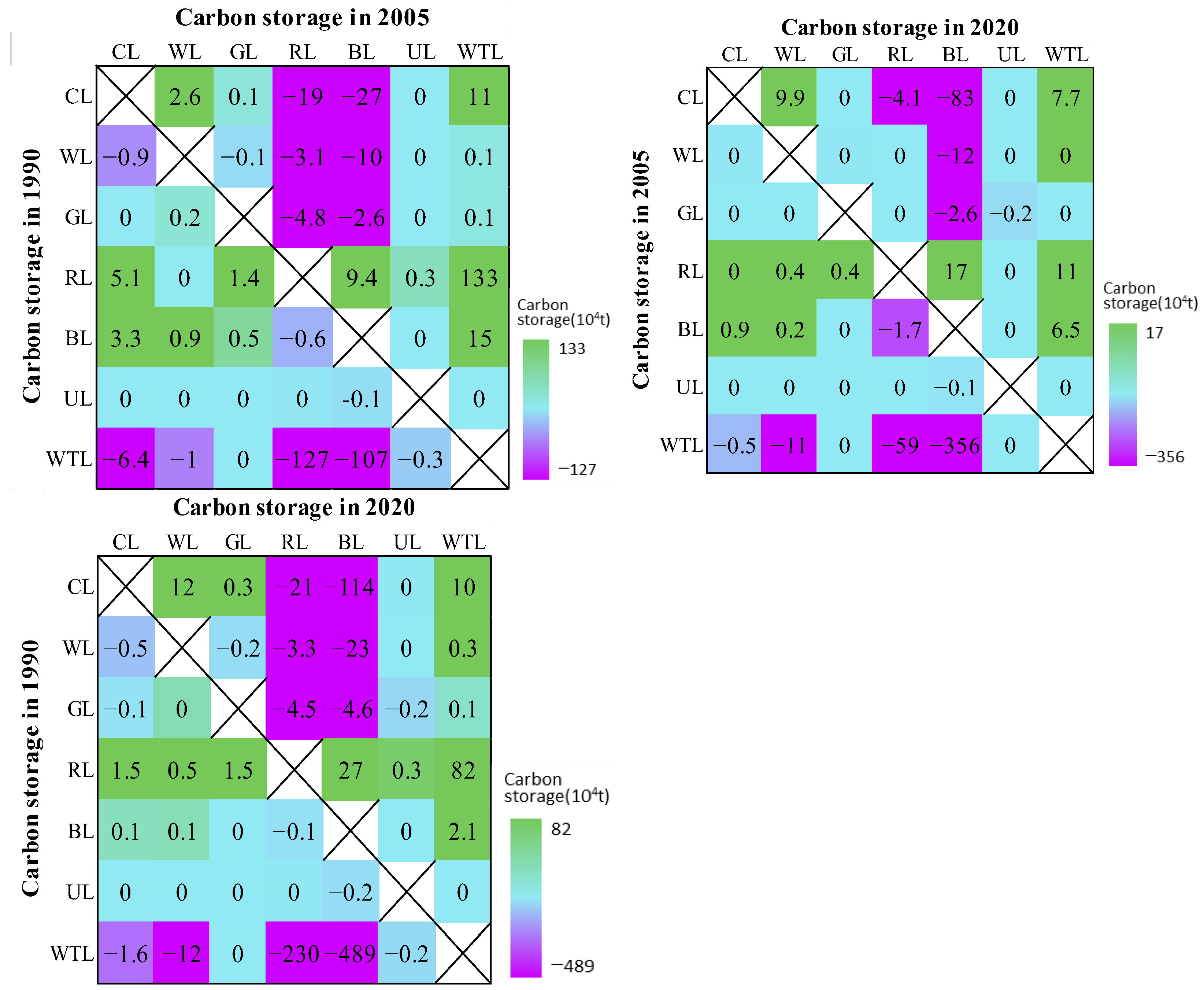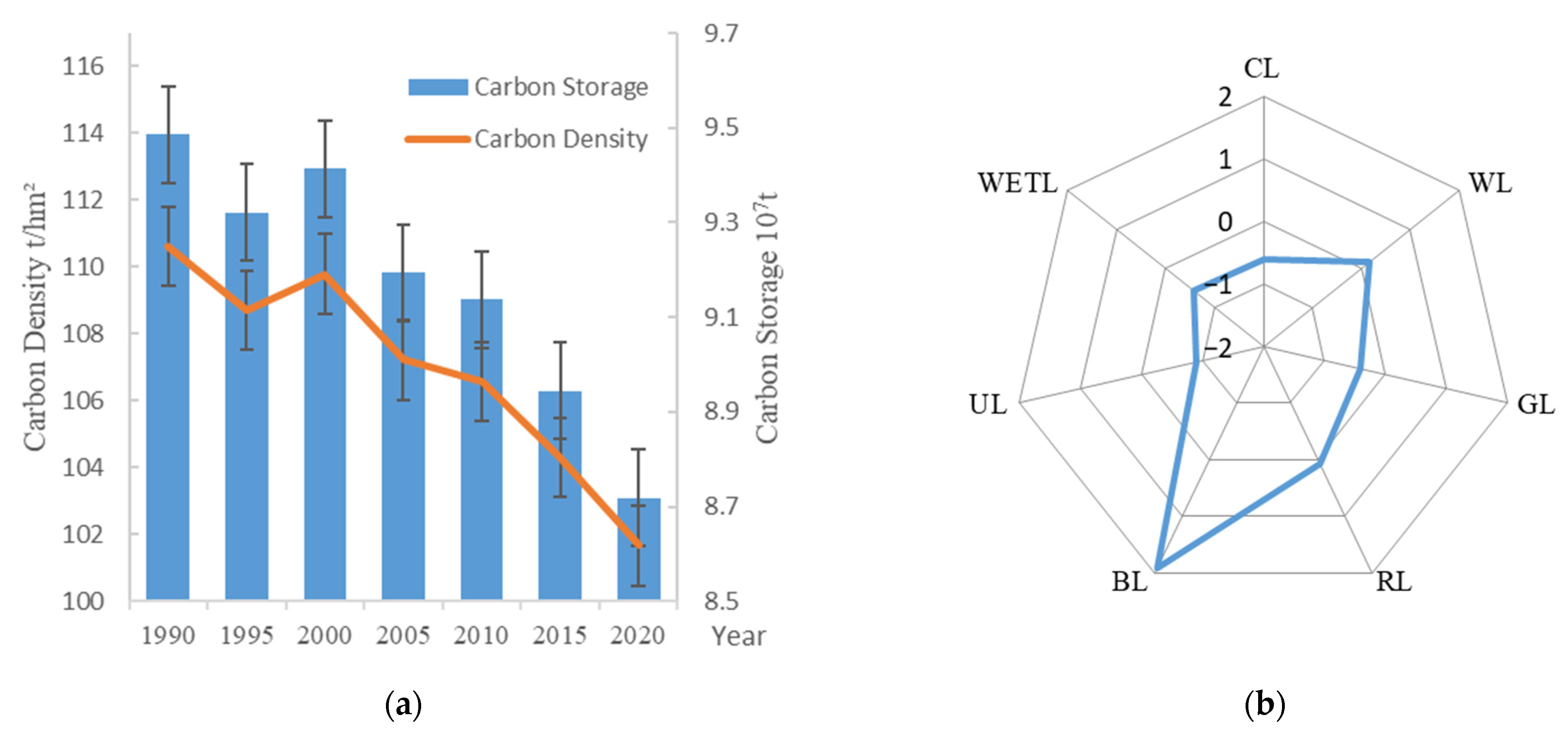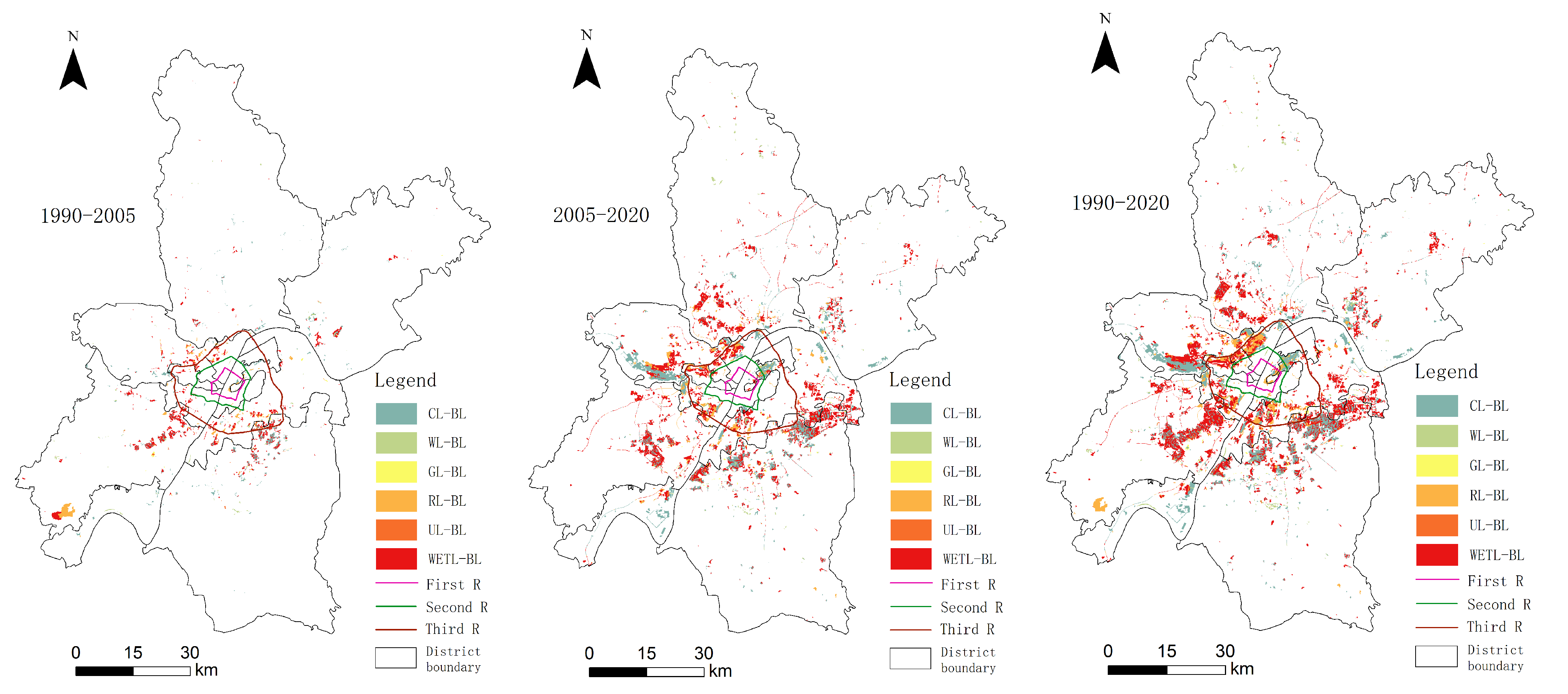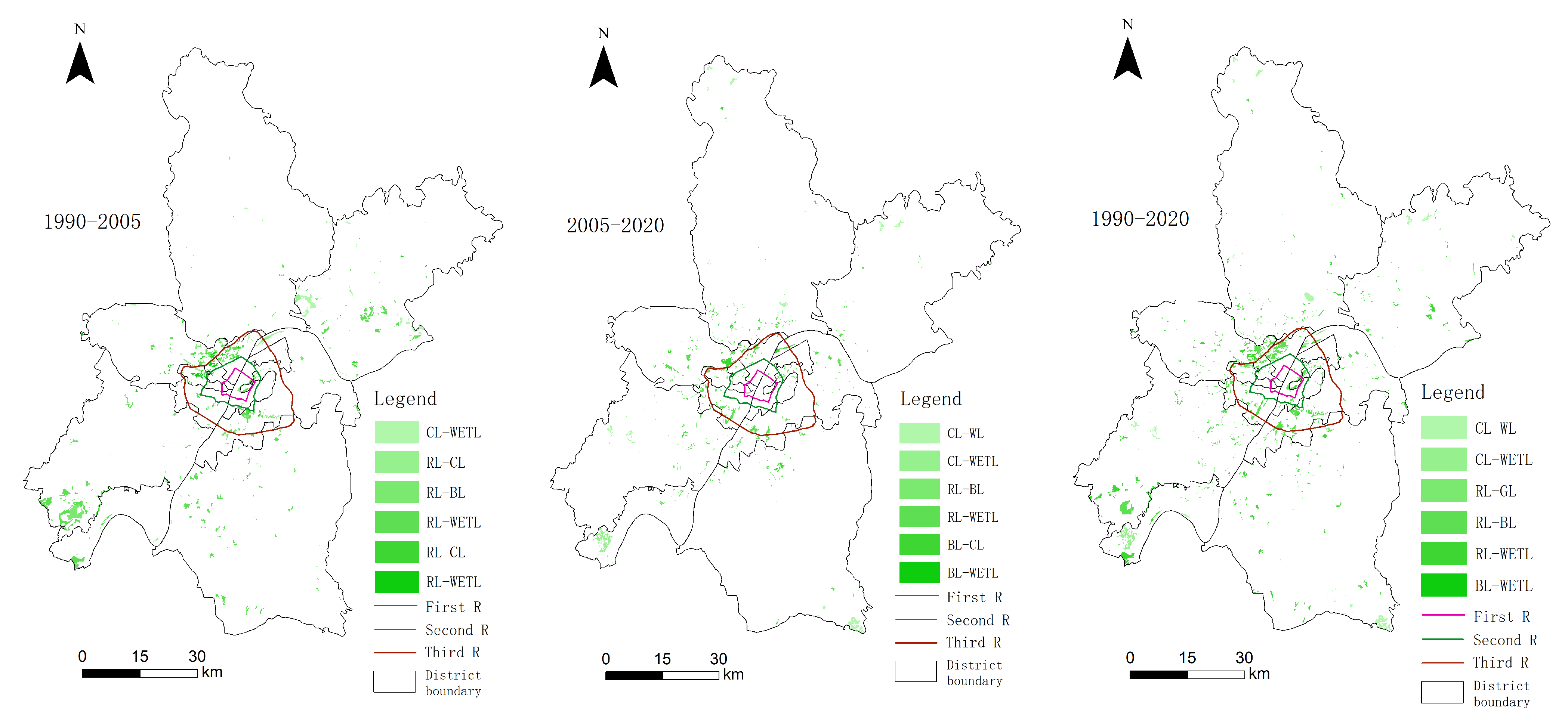Spatiotemporal Changes of Terrestrial Carbon Storage in Rapidly Urbanizing Areas and Their Influencing Factors: A Case Study of Wuhan, China
Abstract
:1. Introduction
2. Theoretical Framework
3. Materials and Methods
3.1. Study Area
3.2. Data and Processing

3.3. Rates of Land-Use Change
3.4. Terrestrial Carbon Storage Assessment Based on InVEST Modeling
3.5. Pearson’s Correlation Coefficient
4. Results
4.1. Characterization of Land-Use Change and Carbon Storage Changes
4.2. Spatial Analysis of Construction Land Expansion and Carbon Storage
4.3. Correlation Analysis of Terrestrial Carbon Storage
5. Discussion
5.1. Impacts of Changes in Land Use and Carbon Storage
5.2. Causes of the Regional Distribution of Carbon Storage
5.3. Policy Implications
6. Conclusions
Author Contributions
Funding
Data Availability Statement
Conflicts of Interest
References
- Agnolucci, P.; Rapti, C.; Alexander, P.; De Lipsis, V.; Holland, R.A.; Eigenbrod, F.; Ekins, P. Impacts of rising temperatures and farm management practices on global yields of 18 crops. Nat. Food 2020, 1, 562–571. [Google Scholar] [CrossRef] [PubMed]
- Solomon, S.; Plattner, G.K.; Knutti, R.; Friedlingstein, P. Irreversible climate change due to carbon dioxide emissions. Proc. Natl. Acad. Sci. USA 2009, 106, 1704–1709. [Google Scholar] [CrossRef] [PubMed]
- IPCC. Intergovernmental Panel on Climate Change; IPCC Secretariat: Geneva, Switzerland, 2021. [Google Scholar]
- Li, J.S.; Guo, X.M.; Chuai, X.W.; Xie, F.J.; Yang, F.; Gao, R.Y.; Ji, X.P. Reexamine China’s terrestrial ecosystem carbon balance under land use-type and climate change. Land Use Policy 2021, 102, 105275. [Google Scholar] [CrossRef]
- Houghton, R.A.; House, J.I.; Pongratz, J.; van der Werf, G.R.; DeFries, R.S.; Hansen, M.C.; Le Quéré, C.; Ramankutty, N. Carbon emissions from land use and land-cover change. Biogeosciences 2012, 9, 5125–5142. [Google Scholar] [CrossRef]
- He, C.Y.; Zhang, D.; Huang, Q.X.; Zhao, Y.Y. Assessing the potential impacts of urban expansion on regional carbon storage by linking the LUSD-urban and InVEST models. Environ. Model. Softw. 2016, 75, 44–58. [Google Scholar] [CrossRef]
- Piao, S.L.; Fang, J.Y.; Ciais, P.; Peylin, P.; Huang, Y.; Sitch, S.; Wang, T. The carbon balance of terrestrial ecosystems in China. Nature 2009, 458, 1009–1013. [Google Scholar] [CrossRef]
- Schimel, D.S.; House, J.I.; Hibbard, K.A.; Bousquet, P.; Ciais, P.; Peylin, P.; Braswell, B.H.; Apps, M.J.; Baker, D.; Bondeau, A.; et al. Recent patterns and mechanisms of carbon exchange by terrestrial ecosystems. Nature 2001, 414, 169–172. [Google Scholar] [CrossRef] [PubMed]
- Fang, H.Y.; Ji, B.Y.; Deng, X.; Ying, J.Y.; Zhou, G.M.; Shi, Y.J.; Xu, L.; Tao, J.X.; Zhou, Y.F.; Li, C.; et al. Effects of topographic factors and aboveground vegetation carbon stocks on soil organic carbon in Moso bamboo forests. Plant Soil 2018, 433, 363–376. [Google Scholar] [CrossRef]
- Privitera, R.; Palermo, V.; Martinico, F.; Fichera, A.; La Rosa, D. Towards lower carbon cities: Urban morphology contribution in climate change adaptation strategies. Eur. Plan. Stud. 2018, 26, 812–837. [Google Scholar] [CrossRef]
- Feng, Y.J.; Chen, S.R.; Tong, X.H.; Lei, Z.K.; Gao, C.; Wang, J.F. Modeling changes in China’s 2000-2030 carbon stock caused by land use change. J. Clean. Prod. 2020, 252, 119659. [Google Scholar] [CrossRef]
- Chuai, X.W.; Huang, X.J.; Wang, W.J.; Zhao, R.Q.; Zhang, M.; Wu, C.Y. Land use, total carbon emission’s change and low carbon land management in Coastal Jiangsu, China. J. Clean. Prod. 2015, 103, 77–86. [Google Scholar] [CrossRef]
- Pickett, S.T.; Cadenasso, M.L.; Grove, J.M.; Nilon, C.H.; Pouyat, R.V.; Zipperer, W.C.; Costanza, R. Urban ecological systems: Linking terrestrial ecological, physical, and socioeconomic components of metropolitan areas. Annu. Rev. Ecol. Syst. 2001, 32, 127–157. [Google Scholar] [CrossRef]
- Collins, J.P.; Kinzig, A.; Grimm, N.B.; Fagan, W.F.; Hope, D.; Wu, J.; Borer, E.T. A New Urban Ecology Modeling human communities as integral parts of ecosystems poses special problems for the development and testing of ecological theory. Am. Sci. 2000, 88, 416–425. [Google Scholar] [CrossRef]
- Chave, J.; Rejou-Mechain, M.; Burquez, A.; Chidumayo, E.; Colgan, M.S.; Delitti, W.B.; Duque, A.; Eid, T.; Fearnside, P.M.; Goodman, R.C.; et al. Improved allometric models to estimate the aboveground biomass of tropical trees. Glob. Change Biol. 2014, 20, 3177–3190. [Google Scholar] [CrossRef] [PubMed]
- Davidson, E.A.; Janssens, I.A. Temperature sensitivity of soil carbon decomposition and feedbacks to climate change. Nature 2006, 440, 165–173. [Google Scholar] [CrossRef]
- Hutyra, L.R.; Yoon, B.; Hepinstall-Cymerman, J.; Alberti, M. Carbon consequences of land cover change and expansion of urban lands: A case study in the Seattle metropolitan region. Landsc. Urban Plan. 2011, 103, 83–93. [Google Scholar] [CrossRef]
- Picchio, R.; Tavankar, F.; Rafie, H.; Kivi, A.R.; Jourgholami, M.; Lo Monaco, A. Carbon Storage in Biomass and Soil after Mountain Landscape Restoration: Pinus nigra and Picea abies Plantations in the Hyrcanian Region. Land 2022, 11, 422. [Google Scholar] [CrossRef]
- Ren, Y.; Wei, X.; Wei, X.H.; Pan, J.Z.; Xie, P.P.; Song, X.D.; Peng, D.; Zhao, J.Z. Relationship between vegetation carbon storage and urbanization: A case study of Xiamen, China. For. Ecol. Manag. 2011, 261, 1214–1223. [Google Scholar] [CrossRef]
- Meng, Y.C.; Gou, R.K.; Bai, J.K.; Moreno-Mateos, D.; Davis, C.C.; Wan, L.M.; Song, S.S.; Zhang, H.S.; Zhu, X.S.; Lin, G.H. Spatial patterns and driving factors of carbon stocks in mangrove forests on Hainan Island, China. Glob. Ecol. Biogeogr. 2022, 31, 1692–1706. [Google Scholar] [CrossRef]
- Houghton, R.A. Carbon emissions and the drivers of deforestation and forest degradation in the tropics. Curr. Opin. Environ. Sustain. 2012, 4, 597–603. [Google Scholar] [CrossRef]
- Ramankutty, N.; Gibbs, H.K.; Achard, F.; Defriess, R.; Foley, J.A.; Houghton, R.A. Challenges to estimating carbon emissions from tropical deforestation. Glob. Change Biol. 2007, 13, 51–66. [Google Scholar] [CrossRef]
- Baccini, A.; Goetz, S.J.; Walker, W.S.; Laporte, N.T.; Sun, M.; Sulla-Menashe, D.; Hackler, J.; Beck, P.S.A.; Dubayah, R.; Friedl, M.A.; et al. Estimated carbon dioxide emissions from tropical deforestation improved by carbon-density maps. Nat. Clim. Change 2012, 2, 182–185. [Google Scholar] [CrossRef]
- Chen, Y.; Yue, W.Z.; Liu, X.; Zhang, L.L.; Chen, Y.A. Multi-Scenario Simulation for the Consequence of Urban Expansion on Carbon Storage: A Comparative Study in Central Asian Republics. Land 2021, 10, 608. [Google Scholar] [CrossRef]
- Jiang, W.G.; Deng, Y.; Tang, Z.H.; Lei, X.; Chen, Z. Modelling the potential impacts of urban ecosystem changes on carbon storage under different scenarios by linking the CLUE-S and the InVEST models. Ecol. Model. 2017, 345, 30–40. [Google Scholar] [CrossRef]
- Liu, Q.; Yang, D.D.; Cao, L.; Anderson, B. Assessment and Prediction of Carbon Storage Based on Land Use/Land Cover Dynamics in the Tropics: A Case Study of Hainan Island, China. Land 2022, 11, 244. [Google Scholar] [CrossRef]
- Liu, K.; Zhang, C.Z.; Zhang, H.; Xu, H.; Xia, W. Spatiotemporal Variation and Dynamic Simulation of Ecosystem Carbon Storage in the Loess Plateau Based on PLUS and InVEST Models. Land 2023, 12, 1065. [Google Scholar] [CrossRef]
- Dixon, R.K.; Brown, S.; Houghton, R.A.; Solomon, A.M.; Trexler, M.C.; Wisniewski, J. Carbon pools and flux of global forest ecosystems. Science 1994, 263, 185–190. [Google Scholar] [CrossRef]
- Schimel, D.S. Terrestrial ecosystems and the carbon-cycle. Glob. Change Biol. 1995, 1, 77–91. [Google Scholar] [CrossRef]
- Girmay, G.; Singh, B.R.; Mitiku, H.; Borresen, T.; Lal, R. Carbon stocks in Ethiopian soils in relation to land use and soil management. Land Degrad. Dev. 2008, 19, 351–367. [Google Scholar] [CrossRef]
- Jiang, Z.; Lin, B. China’s energy demand and its characteristics in the industrialization and urbanization process. Energy Policy 2012, 49, 608–615. [Google Scholar] [CrossRef]
- Houghton, R.A.; Hackler, J.L. Emissions of carbon from forestry and land-use change in tropical Asia. Glob. Change Biol. 1999, 5, 481–492. [Google Scholar] [CrossRef]
- Wang, S.H.; Huang, S.L.; Huang, P.J. Can spatial planning really mitigate carbon dioxide emissions in urban areas? A case study in Taipei, Taiwan. Landsc. Urban Plan. 2018, 169, 22–36. [Google Scholar] [CrossRef]
- Chen, R.; Chen, Y.; Lyulyov, O.; Pimonenko, T. Interplay of Urbanization and Ecological Environment: Coordinated Development and Drivers. Land 2023, 12, 1459. [Google Scholar] [CrossRef]
- Fornara, D.; Olave, R.; Higgins, A. Evidence of low response of soil carbon stocks to grassland intensification. Agric. Ecosyst. Environ. 2020, 287, 106705. [Google Scholar] [CrossRef]
- Wei, Y.D.; Ye, X.Y. Urbanization, urban land expansion and environmental change in China. Stoch. Environ. Res. Risk Assess. 2014, 28, 757–765. [Google Scholar] [CrossRef]
- Zou, H.; Duan, X.J.; Jin, T.T. Urban Chemical Industrial Cluster Area Restructuring and Determinants: A Case Study of a Typical Old Chemical Industry Area Along the Yangtze River, China. Chin. Geogr. Sci. 2022, 32, 237–250. [Google Scholar] [CrossRef]
- Feng, X.H.; Xiu, C.L.; Bai, L.M.; Zhong, Y.X.; Wei, Y. Comprehensive evaluation of urban resilience based on the perspective of landscape pattern: A case study of Shenyang city. Cities 2020, 104, 102722. [Google Scholar] [CrossRef]
- Zou, N.; Wang, C.; Wang, S.Y.; Li, Y.Y. Impact of ecological conservation policies on land use and carbon stock in megacities at different stages of development. Heliyon 2023, 9, E18814. [Google Scholar] [CrossRef]
- Zhang, Y.; Liu, Y.F.; Wang, Y.H.; Liu, D.F.; Xia, C.; Wang, Z.Y.; Wang, H.F.; Liu, Y.L. Urban expansion simulation towards low-carbon development: A case study of Wuhan, China. Sustain. Cities Soc. 2020, 63, 102455. [Google Scholar] [CrossRef]
- Wang, F.; Fan, W.N.; Liu, J.; Wang, G.; Chai, W. The effect of urbanization and spatial agglomeration on carbon emissions in urban agglomeration. Environ. Sci. Pollut. Res. 2020, 27, 24329–24341. [Google Scholar] [CrossRef]
- Liu, X.P.; Wang, S.J.; Wu, P.J.; Feng, K.S.; Hubacek, K.; Li, X.; Sun, L.X. Impacts of Urban Expansion on Terrestrial Carbon Storage in China. Environ. Sci. Technol. 2019, 53, 6834–6844. [Google Scholar] [CrossRef]
- Xu, X.L.; Liu, J.Y.; Zhang, S.W.; Li, R.D.; Yan, C.Z.; Wu, S.X. Remote Sensing Dataset for Land Cover Detection for Multi-period Land Use in China(CNLUCC). Data Regist. Publ. Syst. Resour. Environ. Sci. Data Cent. Chin. Acad. Sci. (CAS) 2018, 90–108. [Google Scholar] [CrossRef]
- GB/T 21010-2017; Current Land Use Classification. National Standards of People’s Republic of China: Beijing, China, 2017.
- Zhang, C.; Tian, H.Q.; Chen, G.S.; Chappelka, A.; Xu, X.F.; Ren, W.; Hui, D.F.; Liu, M.L.; Lu, C.Q.; Pan, S.F.; et al. Impacts of urbanization on carbon balance in terrestrial ecosystems of the Southern United States. Environ. Pollut. 2012, 164, 89–101. [Google Scholar] [CrossRef]
- Batjes, N.H. Total carbon and nitrogen in the soils of the world. Eur. J. Soil Sci. 2014, 65, 10–21. [Google Scholar] [CrossRef]
- Xu, L.; He, N.P.; Yu, G.R. 2010s China Terrestrial Ecosystem Carbon Density Dataset. Chin. Sci. Data 2019, 4. [Google Scholar] [CrossRef]
- Tang, L.P.; Ke, X.L.; Zhou, T.; Zheng, W.W.; Wang, L.Y. Impacts of cropland expansion on carbon storage: A case study in Hubei, China. J. Environ. Manag. 2020, 265, 110515. [Google Scholar] [CrossRef]
- Houssoukpèvi, I.A.; le Maire, G.; Aholoukpè, H.N.S.; Fassinou, D.J.M.; Amadji, G.L.; Chapuis-Lardy, L.; Chevallier, T. Effect of land use change on carbon stocks in an agricultural region of southern Benin. Land Degrad. Dev. 2023, 34, 1447–1463. [Google Scholar] [CrossRef]
- Gao, R.Y.; Chuai, X.W.; Ge, J.F.; Wen, J.Q.; Zhao, R.Q.; Zuo, T.H. An integrated tele-coupling analysis for requisition-compensation balance and its influence on carbon storage in China. Land Use Policy 2022, 116, 106057. [Google Scholar] [CrossRef]
- Zhang, J.; Li, S.N.; Lin, N.F.; Lin, Y.; Yuan, S.F.; Zhang, L.; Zhu, J.X.; Wang, K.; Gan, M.Y.; Zhu, C.M. Spatial identification and trade-off analysis of land use functions improve spatial zoning management in rapid urbanized areas, China. Land Use Policy 2022, 116, 106058. [Google Scholar] [CrossRef]
- Li, Y.-N.; Cai, M.; Wu, K.; Wei, J. Decoupling analysis of carbon emission from construction land in Shanghai. J. Clean. Prod. 2019, 210, 25–34. [Google Scholar] [CrossRef]
- Ma, J.W.; Huang, S.F.; Xu, Z.N. Remote Sensing-Based Dynamic Monitoring and Analysis of Lake Watershed Area in Wuhan City from 1973-2015. J. Water Resour. 2017, 48, 903–913. [Google Scholar] [CrossRef]
- Wang, Y.L.; Liang, D.D.; Wang, J.; Zhang, Y.J.; Chen, F.; Ma, X.Y. An analysis of regional carbon stock response under land use structure change and multi-scenario prediction, a case study of Hefei, China. Ecol. Indic. 2023, 151, 110293. [Google Scholar] [CrossRef]
- Wang, Y.; Li, X.M.; Zhang, F.; Wang, W.W.; Xiao, R.B. Effects of rapid urbanization on ecological functional vulnerability of the land system in Wuhan, China: A flow and stock perspective. J. Clean. Prod. 2020, 248, 119284. [Google Scholar] [CrossRef]
- Xu, Q.; Yang, R.; Dong, Y.X.; Liu, Y.X.; Qiu, L.R. The influence of rapid urbanization and land use changes on terrestrial carbon sources/sinks in Guangzhou, China. Ecol. Indic. 2016, 70, 304–316. [Google Scholar] [CrossRef]
- Yang, Y.; Zhang, Y.Y.; Yang, H.; Yang, F.Y. Horizontal ecological compensation as a tool for sustainable development of urban agglomerations: Exploration of the realization mechanism of Guanzhong Plain urban agglomeration in China. Environ. Sci. Policy 2022, 137, 301–313. [Google Scholar] [CrossRef]
- Deng, Y.; Sarkar, A.; Yu, C.; Lu, Q.; Zhao, M.J.; Das, J.C. Ecological compensation of grain trade within urban, rural areas and provinces in China: A prospect of a carbon transfer mechanism. Environ. Dev. Sustain. 2021, 23, 16688–16712. [Google Scholar] [CrossRef]
- Muñiz, I.; Calatayud, D.; Dobaño, R. The compensation hypothesis in Barcelona measured through the ecological footprint of mobility and housing. Landsc. Urban Plan. 2013, 113, 113–119. [Google Scholar] [CrossRef]
- Liu, S.W.; Zhang, P.Y.; Wang, Z.Y.; Liu, W.X.; Tan, J.T. Measuring the sustainable urbanization potential of cities in Northeast China. J. Geogr. Sci. 2016, 26, 549–567. [Google Scholar] [CrossRef]
- Shen, L.Y.; Peng, Y.; Zhang, X.L.; Wu, Y.Z. An alternative model for evaluating sustainable urbanization. Cities 2012, 29, 32–39. [Google Scholar] [CrossRef]
- Sun, J.F.; Zhang, Y.; Qin, W.S.; Chai, G.Q. Estimation and Simulation of Forest Carbon Stock in Northeast China Forestry Based on Future Climate Change and LUCC. Remote Sens. 2022, 14, 3653. [Google Scholar] [CrossRef]
- Wang, Y.N.; Chang, Q.; Li, X.Y. Promoting sustainable carbon sequestration of plants in urban greenspace by planting design: A case study in parks of Beijing. Urban For. Urban Green. 2021, 64, 127291. [Google Scholar] [CrossRef]
- Conant, R.T.; Cerri, C.E.P.; Osborne, B.B.; Paustian, K. Grassland management impacts on soil carbon stocks: A new synthesis. Ecol. Appl. 2017, 27, 662–668. [Google Scholar] [CrossRef]
- Xu, Y.M.; Xie, Y.J.; Wu, X.D.; Xie, Y.T.; Zhang, T.Y.; Zou, Z.X.; Zhang, R.T.; Zhang, Z.Q. Evaluating temporal-spatial variations of wetland ecosystem service value in China during 1990–2020 from the donor side based on cosmic exergy. J. Clean. Prod. 2023, 414, 137485. [Google Scholar] [CrossRef]
- Gomes, L.C.; Faria, R.M.; de Souza, E.; Veloso, G.V.; Schaefer, C.; Fernandes, E.I. Modelling and mapping soil organic carbon stocks in Brazil. Geoderma 2019, 340, 337–350. [Google Scholar] [CrossRef]
- Mitran, T.; Mishra, U.; Lal, R.; Ravisankar, T.; Sreenivas, K. Spatial distribution of soil carbon stocks in a semi-arid region of India. Geoderma Reg. 2018, 15, e00192. [Google Scholar] [CrossRef]
- Wang, Z.; Zeng, J.; Chen, W.X. Impact of urban expansion on carbon storage under multi-scenario simulations in Wuhan, China. Environ. Sci. Pollut. Res. 2022, 29, 45507–45526. [Google Scholar] [CrossRef]
- Tao, Y.; Li, F.; Liu, X.S.; Zhao, D.; Sun, X.; Xu, L.F. Variation in ecosystem services across an urbanization gradient: A study of terrestrial carbon stocks from Changzhou, China. Ecol. Model. 2015, 318, 210–216. [Google Scholar] [CrossRef]
- Eigenbrod, F.; Bell, V.A.; Davies, H.N.; Heinemeyer, A.; Armsworth, P.R.; Gaston, K.J. The impact of projected increases in urbanization on ecosystem services. Proc. R. Soc. B Biol. Sci. 2011, 278, 3201–3208. [Google Scholar] [CrossRef]








| LULC Types | Code | Aboveground Carbon | Belowground Carbon | Soil Organic Carbon | Dead Organic Matter Carbon |
|---|---|---|---|---|---|
| Cropland | CL | 6.1 | 0.6 | 85.25 | 0 |
| Woodland | WL | 29.25 | 6.151 | 103.28 | 2.78 |
| Grassland | GL | 14.29 | 17.15 | 87.05 | 7.28 |
| Water | RL | 0 | 0 | 14.1 | 0 |
| Construction Land | BL | 7.61 | 1.52 | 34.33 | 0 |
| Unused Land | UL | 10.36 | 2.07 | 34.42 | 0.96 |
| Wetland | WETL | 7.13 | 4.51 | 150.72 | 3.98 |
| Pearson Correlation | Sig. Bobtail | |
|---|---|---|
| Urbanization rate | −0.927 * | 0.024 |
| Proportion of urban built-up area | 0.593 | 0.292 |
| Proportion of land used for industrial and mining construction | −0.952 * | 0.013 |
| Proportion of secondary industry | 0.748 | 0.146 |
| Proportion of tertiary industry | −0.912 * | 0.031 |
| GDP per capita | −0.950 * | 0.013 |
| Disposable income of the urban population | −0.964 ** | 0.008 |
| Average annual temperature | 0.639 | 0.246 |
| Average annual precipitation | −0.907 * | 0.033 |
Disclaimer/Publisher’s Note: The statements, opinions and data contained in all publications are solely those of the individual author(s) and contributor(s) and not of MDPI and/or the editor(s). MDPI and/or the editor(s) disclaim responsibility for any injury to people or property resulting from any ideas, methods, instructions or products referred to in the content. |
© 2023 by the authors. Licensee MDPI, Basel, Switzerland. This article is an open access article distributed under the terms and conditions of the Creative Commons Attribution (CC BY) license (https://creativecommons.org/licenses/by/4.0/).
Share and Cite
Xing, S.; Yang, S.; Sun, H.; Wang, Y. Spatiotemporal Changes of Terrestrial Carbon Storage in Rapidly Urbanizing Areas and Their Influencing Factors: A Case Study of Wuhan, China. Land 2023, 12, 2134. https://doi.org/10.3390/land12122134
Xing S, Yang S, Sun H, Wang Y. Spatiotemporal Changes of Terrestrial Carbon Storage in Rapidly Urbanizing Areas and Their Influencing Factors: A Case Study of Wuhan, China. Land. 2023; 12(12):2134. https://doi.org/10.3390/land12122134
Chicago/Turabian StyleXing, Shuxuan, Shengfu Yang, Haonan Sun, and Yi Wang. 2023. "Spatiotemporal Changes of Terrestrial Carbon Storage in Rapidly Urbanizing Areas and Their Influencing Factors: A Case Study of Wuhan, China" Land 12, no. 12: 2134. https://doi.org/10.3390/land12122134
APA StyleXing, S., Yang, S., Sun, H., & Wang, Y. (2023). Spatiotemporal Changes of Terrestrial Carbon Storage in Rapidly Urbanizing Areas and Their Influencing Factors: A Case Study of Wuhan, China. Land, 12(12), 2134. https://doi.org/10.3390/land12122134





